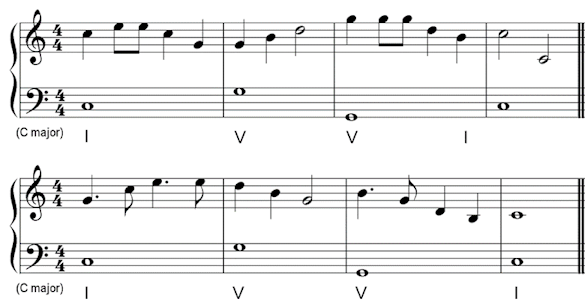Composing at Grade 3
For Trinity grade 3 music theory you may be asked to add a tune to a bass line, or add a bass line to a tune, to create a composition with two separate parts. To do this successfully, you first need to learn about how two individual musical parts work together in similar motion, or contrary motion.
When you’ve understood the different types of motion, then next step is to look at how both parts share the same harmony, although they might use different notes from each chord.
Once you have mastered these two tasks, the obvious way to extend your skills is to try to create both a bass line AND a tune to go with it.
Writing a Bass Line to a Tune
In the Trinity exam you may be asked to write a simple bass line to fit a given tune. The bass line will only use the tonic or dominant notes of the key the music is in, like this example which is in D major. The bass line is on the bass clef stave.

In D major the tonic note is D, and the dominant is A, so these are the two notes that are used in the bass line.
Each note in the bass line lasts for the whole bar. This piece is in 3/4 time, so a note which lasts the whole bar is a dotted minim (dotted half note).
The bass should mostly move in contrary motion with the tune, in order to avoid consecutive 5ths and octaves.
If you use the same chord twice in a row, you can use the same bass note, (see bars 2-3), or you might prefer to move to the same note in a different register as this can help to avoid consecutives.
Chords can be shown as either Roman numerals (I and V), or they can be shown with letter chord symbols, as in the example above.
Writing a Tune to a Bass Line
The music in this lesson is going to be built on this bass line:

The Roman numerals under each bass note tell you which chord the bass note belongs to. These are all root position chords of either the tonic, or dominant. You might find letter chord symbols above the stave instead.
The notes in the tune, (treble clef stave), will belong to the same chords, so in bar 1, the tune will be made of notes that can be found in chord I, and in bar 2 it will be notes that we can find in chord V, and so on.
Here are two tunes that work well.

What is it about these tunes that makes them work?
- The rhythms work for the given time signature. The last note should be reasonably long – at least the value of one beat, but better to use a note that lasts half a bar, or a whole bar.
- In most bars, there are 2 or all 3 notes of the triad used to make the melody. Try to include two or three triad notes in most bars, and always end on the tonic note.
- Avoid moving by consecutive 5ths and octaves in similar motion.
- Move to nearby notes – avoid large leaps up and down. (The biggest interval used is the octave leap in the first example, which is from a tonic to another tonic.)
Here are some tunes that could be improved:

Here, the arpeggio patterns create a very big leap between bars 3-4. The last bar does not use a long enough note, and it should also end on the tonic (this ends on the 3rd degree of the scale).

Here, there is only one pitch used in each bar. More variety would be better. It also contains some illegal consecutive 5ths and octaves:

These similar motion consecutives would lose points in an exam. Be sure to keep the bass and tune moving in contrary motion, if you are moving in 5ths or octaves at each bar line.
In a minor key piece of music, don’t forget that you will need to raise the 7th degree of the scale by a semitone, to fit the major version of chord V (for example, the notes for chord V in A minor are E, G# and B. You will need to use an accidental sharp on any Gs that you write).